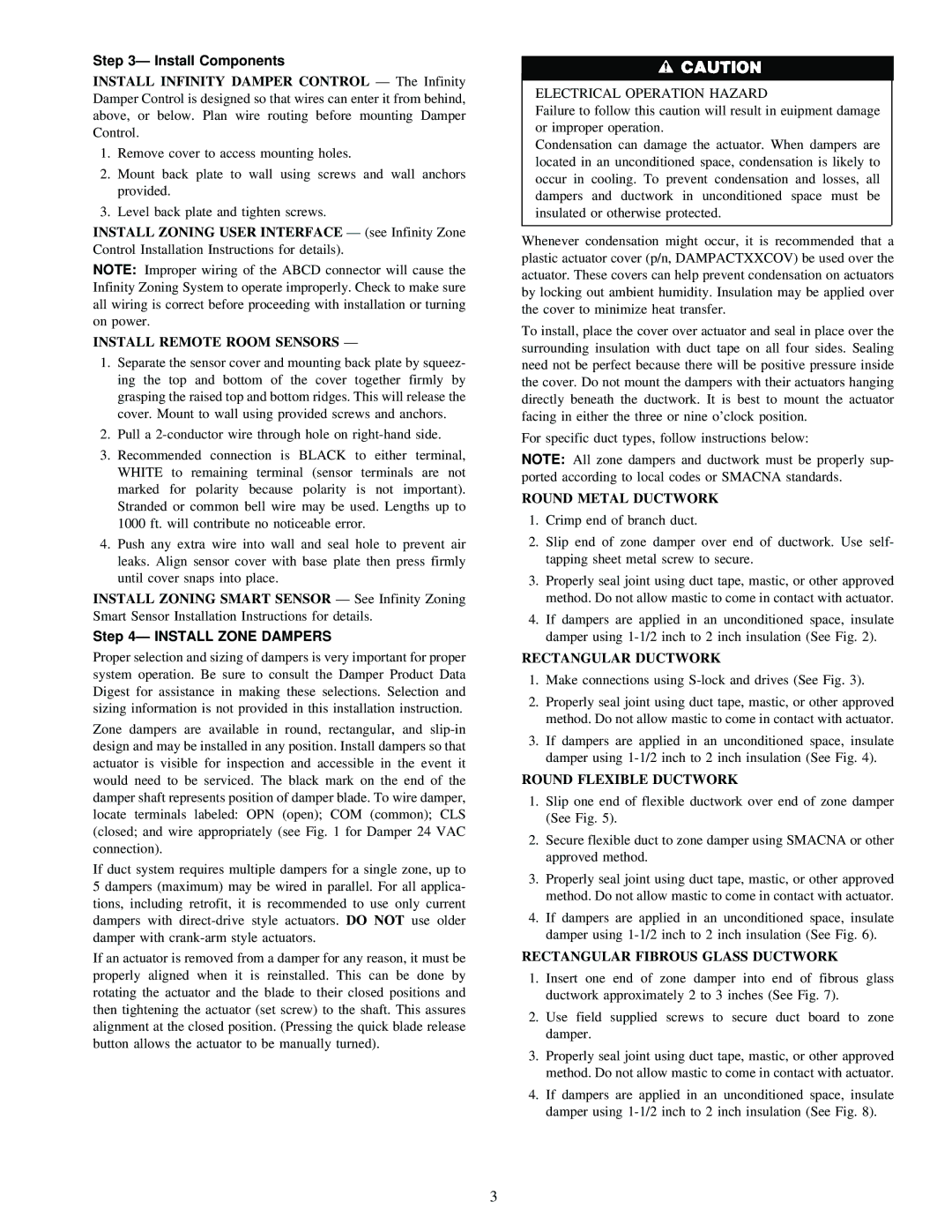Step 3— Install Components
INSTALL INFINITY DAMPER CONTROL — The Infinity Damper Control is designed so that wires can enter it from behind, above, or below. Plan wire routing before mounting Damper Control.
1.Remove cover to access mounting holes.
2.Mount back plate to wall using screws and wall anchors provided.
3.Level back plate and tighten screws.
INSTALL ZONING USER INTERFACE — (see Infinity Zone Control Installation Instructions for details).
NOTE: Improper wiring of the ABCD connector will cause the Infinity Zoning System to operate improperly. Check to make sure all wiring is correct before proceeding with installation or turning on power.
INSTALL REMOTE ROOM SENSORS —
1.Separate the sensor cover and mounting back plate by squeez- ing the top and bottom of the cover together firmly by grasping the raised top and bottom ridges. This will release the cover. Mount to wall using provided screws and anchors.
2.Pull a 2-conductor wire through hole on right-hand side.
3.Recommended connection is BLACK to either terminal, WHITE to remaining terminal (sensor terminals are not marked for polarity because polarity is not important). Stranded or common bell wire may be used. Lengths up to 1000 ft. will contribute no noticeable error.
4.Push any extra wire into wall and seal hole to prevent air leaks. Align sensor cover with base plate then press firmly until cover snaps into place.
INSTALL ZONING SMART SENSOR — See Infinity Zoning Smart Sensor Installation Instructions for details.
Step 4— INSTALL ZONE DAMPERS
Proper selection and sizing of dampers is very important for proper system operation. Be sure to consult the Damper Product Data Digest for assistance in making these selections. Selection and sizing information is not provided in this installation instruction.
Zone dampers are available in round, rectangular, and slip-in design and may be installed in any position. Install dampers so that actuator is visible for inspection and accessible in the event it would need to be serviced. The black mark on the end of the damper shaft represents position of damper blade. To wire damper, locate terminals labeled: OPN (open); COM (common); CLS (closed; and wire appropriately (see Fig. 1 for Damper 24 VAC connection).
If duct system requires multiple dampers for a single zone, up to 5 dampers (maximum) may be wired in parallel. For all applica- tions, including retrofit, it is recommended to use only current dampers with direct-drive style actuators. DO NOT use older damper with crank-arm style actuators.
If an actuator is removed from a damper for any reason, it must be properly aligned when it is reinstalled. This can be done by rotating the actuator and the blade to their closed positions and then tightening the actuator (set screw) to the shaft. This assures alignment at the closed position. (Pressing the quick blade release button allows the actuator to be manually turned).
ELECTRICAL OPERATION HAZARD
Failure to follow this caution will result in euipment damage or improper operation.
Condensation can damage the actuator. When dampers are located in an unconditioned space, condensation is likely to occur in cooling. To prevent condensation and losses, all dampers and ductwork in unconditioned space must be insulated or otherwise protected.
Whenever condensation might occur, it is recommended that a plastic actuator cover (p/n, DAMPACTXXCOV) be used over the actuator. These covers can help prevent condensation on actuators by locking out ambient humidity. Insulation may be applied over the cover to minimize heat transfer.
To install, place the cover over actuator and seal in place over the surrounding insulation with duct tape on all four sides. Sealing need not be perfect because there will be positive pressure inside the cover. Do not mount the dampers with their actuators hanging directly beneath the ductwork. It is best to mount the actuator facing in either the three or nine o’clock position.
For specific duct types, follow instructions below:
NOTE: All zone dampers and ductwork must be properly sup- ported according to local codes or SMACNA standards.
ROUND METAL DUCTWORK
1.Crimp end of branch duct.
2.Slip end of zone damper over end of ductwork. Use self- tapping sheet metal screw to secure.
3.Properly seal joint using duct tape, mastic, or other approved method. Do not allow mastic to come in contact with actuator.
4.If dampers are applied in an unconditioned space, insulate damper using 1-1/2 inch to 2 inch insulation (See Fig. 2).
RECTANGULAR DUCTWORK
1.Make connections using S-lock and drives (See Fig. 3).
2.Properly seal joint using duct tape, mastic, or other approved method. Do not allow mastic to come in contact with actuator.
3.If dampers are applied in an unconditioned space, insulate damper using 1-1/2 inch to 2 inch insulation (See Fig. 4).
ROUND FLEXIBLE DUCTWORK
1.Slip one end of flexible ductwork over end of zone damper (See Fig. 5).
2.Secure flexible duct to zone damper using SMACNA or other approved method.
3.Properly seal joint using duct tape, mastic, or other approved method. Do not allow mastic to come in contact with actuator.
4.If dampers are applied in an unconditioned space, insulate damper using 1-1/2 inch to 2 inch insulation (See Fig. 6).
RECTANGULAR FIBROUS GLASS DUCTWORK
1.Insert one end of zone damper into end of fibrous glass ductwork approximately 2 to 3 inches (See Fig. 7).
2.Use field supplied screws to secure duct board to zone damper.
3.Properly seal joint using duct tape, mastic, or other approved method. Do not allow mastic to come in contact with actuator.
4.If dampers are applied in an unconditioned space, insulate damper using 1-1/2 inch to 2 inch insulation (See Fig. 8).

